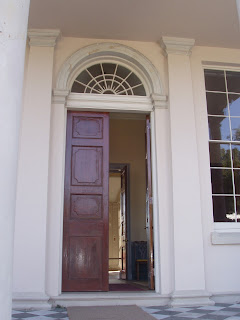Roversdale built between 1801-1807 An entry porch with Tuscan columns
Riversdale a Palladian five-part house built in the Federal style was begun by wealthy Flemish émigré, financier and art collector, Henri Joseph Stier of Antwerp. He, his wife, and children fled the Low Countries in Belgium and the armies of the French Revolutionary Republic in 1793. The Stiers lived briefly in Philadelphia and then moved to Annapolis. In 1799, Stier's younger daughter, Rosalie Eugenie, married George Calvert, a American Aristocrat planter, state legislator, and a descendant of the Lords Baltimore - his father, Benedict Calvert, was a natural son of the fifth Lord Baltimore. George's sister, Eleanor, married George Washington's stepson, John Parke "Jacky" Custis. George and Rosalie spent part of their honeymoon with the Washington's at Mount Vernon before settling on George's tobacco plantation in Prince George's County.
In 1800, Stier bought 729 acres near the port and spa town of Bladensburg and began construction of his new manor house. As construction began, the Stiers rented Bostwick in Bladensburg. They moved into their partially built house in 1802. Plans for the grounds were developed by landscape architect William Russell Birch in 1805.
Meanwhile, conditions in Europe changed as Napoleon Bonaparte declared an amnesty for the émigrés. Mr. and Mrs. Stier and their older children returned to Antwerp, while the Calverts moved into Riversdale and completed it by 1807. The Federal interior is of such high quality as to support the local tradition that attributes the design to William Thornton, architect of the Capitol. For thirteen years Riversdale housed the Peeters/Stier collection of European paintings, which was unique in the United States at that time. It included more than 63 paintings by such artists as Peter Paul Rubens, Anthony Van Dyck, Jan Breughel and Titian. However, most of the larger pieces were kept in storage, and in 1816 they were returned. However, before they were packed, Rembrandt Peale persuaded Rosalie Calvert to display them for two weeks at Riversdale in April 1816. The correspondence between Rosalie Calvert and her family survives and is the basis for Mistress of Riversdale: the Plantation Letters of Rosalie Stier Calvert, edited by Margaret Law Callcott (Baltimore: Johns Hopkins University Press, 1991). These letters provide a rich source for the restoration and interpretation of the house.
She pulls no punches: she hated "Tommy Jeff" and "Queen Dolla lolla" Madison; thought American might benefit from a king; made major investment decisions for her family; described the "rockets' red glare," (glimpsed from her bedroom window); wrote about her husbands infidelity with slaves and oversaw her daughter Caroline's debut into society.
Mrs. Calvert never returned to Europe as she hoped to do. She died at Riversdale in 1821 at age 42 having borne nine children, five of whom lived to maturity. George Calvert did not remarry and died in 1838.
The front doors are topped by a fanlight
The front doors are topped by a fanlight
Front hall
Staircase
The study with Fine imported hand blocked French wallpaper and Baltimore made Federal furniture.
The west parlor was the salle de compagnie.
Doorway in The west parlor was the salle de compagnie.
The east parlor served as the dining room.
The east parlor served as the dining room.
The east parlor served as the dining room.
The east parlor served as the dining room.
Fine imported Neoclassical wool wall-to-wall carpeting
The central parlor, or salon de mileiu, is the most elaborate space, with wood Ionic pilasters, plaster ceiling decoration and a plaster cornice imported from France .
The central parlor, or salon de mileiu, is the most elaborate space, with wood Ionic pilasters, plaster ceiling decoration and a plaster cornice imported from France .
The central parlor, or salon de mileiu, is the most elaborate space, with wood Ionic pilasters, plaster ceiling decoration and a plaster cornice.
The central parlor, or salon de mileiu, is the most elaborate space, with wood Ionic pilasters, plaster ceiling decoration and a plaster cornice.
Triple-sash windows open onto the porch, permitting passage from the porch to the center parlor.
The central parlor, or salon de mileiu, is the most elaborate space, with wood Ionic pilasters, plaster ceiling decoration and a plaster cornice.
The central parlor, or salon de mileiu, is the most elaborate space, with wood Ionic pilasters, plaster ceiling decoration and a plaster cornice.
The interior of the first floor contains three parlors across the south side of the house.
The central parlor, or salon de mileiu, is the most elaborate space, with wood Ionic pilasters, plaster ceiling decoration and a plaster cornice imported from France .
The central parlor, or salon de mileiu, is the most elaborate space, with wood Ionic pilasters, plaster ceiling decoration and a plaster cornice.
Family Old Paris porcelain in China closet
a wine cellar
Federal period Baltimore made desk
Federal mantel in bedroom
Baltimore Federal wishstand with Old Paris porcelain
A collection of Maryland made chairs used at Riversdale
The two story stucco-covered brick building was used as a kitchen, with single spaces on each level.



















































No comments:
Post a Comment